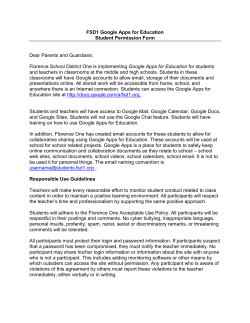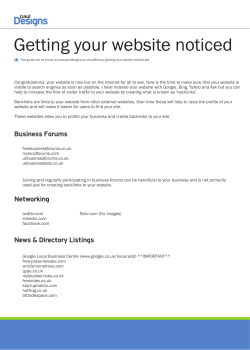
5 Tips to Get More from Google Analytics April 2013
5 Tips to Get More from Google Analytics Authors: Ross Perez and Brett Sheppard April 2013 5 Tips to Get More from Google Analytics p2 Google Analytics has given you many great new Solutions Architect Shiraz Asif shows how to automate features for your website visitor, source, and conversion cross-platform cohort analysis. This can save you time tracking. And there’s even much more you can do when and reduce the manual work of integrating online and you take full advantage of your data from Google offline data. And you can visualize the cohorts as Analytics. custom variable keys across a date range. Ask and answer deeper questions: How well does the respondent audience in your web visits correspond to your target audience? What traffic sources yield the most valuable customers, not just one-time conversions? How can you enable colleagues who are not webanalytics gurus to more fully use and benefit from your website data? What new insights to gain and retain customers can you learn by blending your Google Analytics data with Salesforce.com data or other sources? And how can you do all this quickly, without a lot of manual work? See these five tips to get more from your Google Analytics data. 1 Automate your cohort analysis Many organizations use cohort analysis to understand a class of website visitors, often segmented by a specific action over a defined time period. Cohort analysis can include cross-platform data from the web, mobile web, and offline. For example, when a customer makes the first purchase in a desktop browser and follow-up purchases in a mobile browser and in-store, what is that customer’s lifetime value to date? If you’re not already using cohort analysis, a blog post by Google Analytics advocate Justin Cutroni offers suggestions to get started. Begin by inserting activity conversion dates. Then use custom variables or events Figure 1. Cohort Analysis in Google Analytics + Tableau. See revenue since first purchase for weekly cohort groups. Interested in how to automate cohort analysis for your website data? See how-to tips in an E-Nor blog. 2 Drag & drop advanced analytics Peaks and valleys are interesting, but sometimes what you really want to know are the trends in the overall volume for your website, pages, or groups of pages. If you export to Excel, you can select a line chart in Chart Tools and then follow the Microsoft Office help guide for to create cohorts1. trend lines. Just grab your favorite caffeinated beverage For experienced cohort-analysis pros, you may want interface and steps are less than intuitive. Or, if using ways to simplify the process. In a Google Analytics blog series 2 , E-Nor President Feras Alhlou and Analytics Justin Cutroni, “Cohort Analysis with Google Analysis”, December 11, 2012. 2 Google Analytics blog, Shiraz Asif, “Get Useful Insights Easier: Automate Cohort Analysis with Analytics & Tableau”, March 12, 2013; and E-Nor blog, Feras Alhlou, “Cohort Analysis using Cross Platform Data: Web, Mobile and Offline”, February 27, 2013. 1 first, because for something that should be easy, the Tableau Software, simply bring in your data via Tableau’s direct connector to Google Analytics, rightclick on your chart, and select trend lines. 5 Tips to Get More from Google Analytics p3 Figure 2. Add Trend Lines. See progress in growing total page views despite wide variances by day and week. 3 Do previous page & next page analysis Figure 3. See First to Second Page Path filtered by Multiple Variables. In this sample dashboard showing data for Tableau Public, see second pages filtered by the first page, country, and date range. Flow visualization maps the starting page and 4Blend data subsequent pages. Nodes represent points through Google Analytics. However, you may have Salesforce. With Google Analytics flow visualization reports, you can see how your visitors navigate through content. which traffic flows. A node can be a single page, a directory, an event, or a dimension. With the Visits Flow report, you can see how visitors follow a storyline, such as going from a campaign page to a video and then to a purchase page. Click on any of the nodes and select to see traffic from or to that node. Unfortunately, what you can’t do in the flow visualization reports is filter to see how multiple variables affect previous and next pages. For example, are previous-tonext-page trends different by geography? What about time periods or days of the week? What if you wanted to add even more variables such as customer segments? Google gives you lots of options to bring data into com or other customer relationship management (CRM) data, customer records, market research, demographics, or more data sources that you would like to combine with your website data for fuller insights. Consider integrating market research with your website data. In a blog post, Semphonic President and CTO Gary Angel advocates holding a small tight survey to digital responders to recover one or more core demographics and in some cases even explore some of the offer and creative elements. And you can measure targeting precision – how well does the respondent audience in your web visits correspond to your target To filter previous-to-next-page data by multiple audience.3 variables, you’ll want to export your data from Google For more on website data blending, see this Cardinal Analytics. You may already be exporting from Google Analytics to Excel or column-separated value (.csv) files. Or to save time and reduce that manual work, give Tableau’s direct connector to Google Analytics a try. Path video with Senior Director of Analysis and Insight Melaine Fuentes and Director of Strategic Services Stéphane Hamel.4 Fuentes and Hamel discuss how they drive actionable insights by blending a brand’s website traffic data with additional data sources. Semphonic, “Targeting Precision – Using Opinion Research for Campaign Measurement”, March 10, 2013. 4 Available on YouTube or at the Tableau Software Google Analytics solution page. 3 5 Tips to Get More from Google Analytics p4 5 Share with colleagues Power users can blend Google Analytics and offline data, then share dashboards with colleagues who can filter to areas of interest and answer their own questions. This is a huge time savings for the power users. Retitle jargon into easily understood business terms and group pages, while offering full drill down to individual web pages. This empowers colleagues to more fully use web data and gain insights in their own work. Conclusion Figure 4. Page Usage. There you go, a roundup of five tips to get more from In this example dashboard, give colleagues who author your website visitor, source, and conversion data. Have web content the opportunity to see which content has other suggestions? Email us at the most visits and the longest view times. See the live solutions@tableausoftware.com. New to Tableau? visualization on the Tableau Software website at the Download a full functioning free trial at Google Analytics solution page. http://www.tableausoftware.com/products/trial. About Tableau Tableau Software helps people see and understand data. Tableau helps anyone quickly analyze, visualize and share information. More than 10,000 organizations get rapid results with Tableau in the office and on-the-go. And tens of thousands of people use Tableau Public to share data in their blogs and websites. See how Tableau can help you by downloading the free trial at www.tableausoftware.com/trial. Tableau and Tableau Software are trademarks of Tableau Software, Inc. All other company and product names may be trademarks of the respective companies with which they are associated. © Tableau Software, Inc. 2013. All rights reserved. 837 North 34th Street, Suite 400, Seattle, WA 98103 U.S.A. 5 Tips to Get More from Google Analytics p5
© Copyright 2025





















